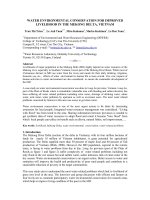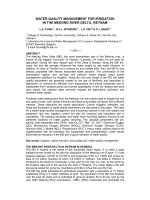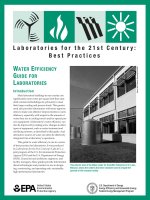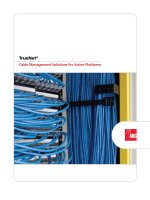Tài liệu Water Efficiency Guide for Laboratories; Laboratories for the 21st ... doc
Bạn đang xem bản rút gọn của tài liệu. Xem và tải ngay bản đầy đủ của tài liệu tại đây (473.72 KB, 12 trang )
ici l
l
i
i l
i
i
i
W E
G
L
i
by
U.S. Department of Energy
Energy Eff ency and Renewab e Energy
Federa Energy Management Program
Un ted States
Env ronmenta
Protect on Agency
L a b o r a t o r e s f o r t h e 2 1 s t C e n t u r y :
B e s t P r a c t c e s
Steve Hall, Hedrick-Blessing/PIX12657
ATER FFICIENCY
UIDE FOR
ABORATORIES
Introduct on
Most laboratory buildings in our country use
significantly more water per square foot than stan-
dard commercial buildings do, primarily to meet
their larger cooling and process loads. This greater
need also provides laboratories with more opportu-
nities to make cost-effective improvements in water
efficiency, especially with respect to the amount of
water they use in cooling towers and for special pro-
cess equipment. A laboratory’s water efficiency can
also be improved by making a few changes in other
types of equipment, such as water treatment and
sterilizing systems, as described in this guide. And
alternative sources of water can often be effectively
integrated into a laboratory’s operations.
This guide to water efficiency is one in a series
of best practices for laboratories. It was produced
Laboratories for the 21st Century
(“Labs 21”), a
joint program of the U.S. Environmental Protection
Agency (EPA) and the U.S. Department of Energy
(DOE). Geared toward architects, engineers, and
facility managers, these guides provide information
about technologies and practices to use in design-
ing, constructing, and operating safe, sustainable,
high-performance laboratories.
This exterior view of the Nidus Center for Scientific Enterprise in St. Louis,
Missouri, shows the cisterns that store rainwater used to irrigate the
grounds of this research facility.
L A B S F O R T H E 2 1 S T C E N T U R Y
3
2
L A B S F O R T H E 2 1 S T C E N T U R Y
Laborator y Co oli ng Towers
Typical Cooling Tower Operation
Drift ("D")
Water with concentrated
mineral salts
Treatment
chemicals
Water
sprayed
downward
Evaporation ("E")
Warm water
Process
heat
source
Cool wate
r
Blowdown ("B")
Water flowing out of a cooling tower
circulates to equipment that needs cooling.
The equipment is cooled; the water is
warmed. The warm water is returned to
the cooling tower where it is re-cooled
and the process begins again.
Cooling towers, which are part of many laboratory
buildings, might represent the largest single opportunity
for greater water efficiency. This is because laboratories
usually have very large comfort-cooling and process
loads. Laboratories often use 100% outside air for ventila
-
tion; this makes their comfort cooling loads higher than
those of most office buildings. Additional cooling is often
needed for special equipment such as lasers and electron
microscopes (see the section on laboratory equipment in
this guide). In fact, from 30% to 60% of all the water used
in multipurpose laboratories is for cooling.
Makeup
back to
water
process
("M")
Recirculating pump
(
also called bleed-off
)
Cooling towers use water in three ways: evaporation,
drift, and bleed-off. Figure 1 illustrates water use in a typi
-
cal cooling tower. Evaporation (E) is fixed and controlled
by thermodynamics; about 2.4 gallons per minute (gpm)
of cooling water is used for every 100 tons of cooling.
Bleed-off (B) contains the concentrated, dissolved solids
and other material left behind from evaporation. Drift (D)
losses are typically a function of tower design. Most of
today’s tower designs reduce drift to about 0.05% to 0.2%.
Since the amounts are small and they contain dissolved
solids, they are usually included in bleed-off. Make-up
(M) water replaces water lost because of E, B, or D.
Cool ing To wer Wat er M a nage ment
The primary methods for managing water use in
cooling towers are operational ones. For example, cool
-
ing towers can be investigated to see if there should be an
Figure 1. Water use in a typical cooling tower
(Source: New Mexico Office of the State Engineer 1999; reprinted with
permission)
results in greater water efficiency (New Mexico Office of
the State Engineer 1999).
Figure 2 shows the effect of the CR on make-up water
use. Note that increasing the CR from 2 to 5 yields almost
85% of the savings that can be obtained by increasing the
cycles from 2 to 10. Increasing the cycling above 6 does
not significantly reduce make-up water use, but it does
increase the likelihood that deposits will form and cause
fouling of the system (Puckorius 2002). Any of several
different parameters can be used to estimate the water
savings for a specific tower, as shown in the sample
calculation.
increase in the concentration ratio (CR) or cycles of con-
centration of water in the tower. The CR is an indication
of how many times water circulates in the tower before it
is bled off and discharged. Increasing the recycle rate of
the tower reduces the consumption of make-up water and
To ca lcul a te t he c o nce n trat ion r ati o (CR )
and a sso c iate d wa t er s avin gs:
Since the CR represents the relationship between the concentration
Gallons/day/100 tons of cooling
7000.0
6000.0
5000.0
4000.0
3000.0
2000.0
1000.0
0.0
Incremental
water savings
2
4
6
8 10 12 14 16 18 20
of dissolved solids in bleed-off (CB) to the concentration in make-up
water (CM), it can be expressed as
CR = CB/CM.
If a cooling tower is metered for bleed-off and make-up water, CR
can be calculated as follows where M is the volume of make-up
water and B is the volume of bleed (in gallons).
CR = M/B.
The amount of water saved by increasing the CR can be calculated as
V
saved
= M1 * (CR2 - CR1)/CR1(CR2 - 1).
Here, V is the total volume saved, M1 is the initial make-up water
volume, CR1 is the initial concentration ratio, and CR2 is the desired
or final concentration ratio.
Concentration ratio (CR)
Figure 2. Incremental water savings
In addition to savings on water and sewer costs, sav-
ings also result from having to purchase fewer chemicals
to treat the water. As the volume of incoming fresh water
is reduced, so is the amount of chemicals needed. Table 1
shows approximate savings on chemical usage resulting
from increasing the CR in a 10,000-gpm system.
Perhaps the best way to increase the cycles of concen-
tration is through better monitoring and management of
the water chemistry. The first step is to understand the
L A B S F O R T H E 2 1 S T C E N T U R Y
2
3
L A B S F O R T H E 2 1 S T C E N T U R Y
Tab le 1. Ch emi cal savings resu lti ng
from in cre asi ng the concentration
ratio of a c ool ing tow er
Cycles
Makeup
(gpm)
Change
(gpm)
Chemical needed
at 100 ppm (lb)
Change
(lb)
1.5 300 240
2 200 100 120 120
4 133 67 40 80
5 125 8 30 10
10 111 14 13.3 16.7
Source: GC3 Specialty Chemicals 2000. Service Document;
www.gc3.com/srvccntr/cycles.htm.
quality of the incoming water and what the controlling
parameter should be, such as hardness, silica, or total dis
-
solved solids. There will be a relationship between these
parameters and conductivity, based on the water chemis
-
try specific to a site. This relationship can help to establish
a conductivity set point. The conductivity controller opens
a blow-down valve as needed to maintain your control
parameter within acceptable limits.
Conductivity and flow meters should be installed
on make-up and bleed-off lines. Meters that display total
water use and current flow rate provide useful informa
-
tion about the status of the tower and cooling system, so
they should be checked regularly to quickly identify prob
-
lems. For example, the conductivity of make-up water and
bleed-off can be compared with the ratio of bleed-off flow
to make-up flow. If both ratios are not about the same,
the tower should be checked for leaks or other unwanted
draw-offs.
It is important to select a chemical treatment vendor
carefully—one who understands that water efficiency
is a high priority. Vendors should provide estimates of
the quantities and costs of treatment chemicals, bleed-off
water volumes, and expected CR. Criteria for selecting a
vendor should include the estimated cost of treating 1000
gallons of make-up water and the highest recommended
cycle of concentration for the water system.
New construction and renovation projects are excel-
lent opportunities to design for greater water efficiency. A
plume abatement or hybrid tower is one design that can
have an impact on water use, even if the primary reason
for it is to reduce the visible plume* emanating from large
industrial towers. A smaller plume is desirable in many
residential areas and in areas where visibility is important,
such as near airport runways.
* A plume is the visible column of saturated air exiting a
conventional cooling tower.
Hybrid towers have both a wet and a dry cooling sec-
tion (Figure 3). The tower can be run in wet mode in the
summer, when the plume is less problematic, at the high
-
est efficiency. In winter, the tower can be run in either dry
or wet/dry mode. When operating in this mode, the dry
section warms the exit air stream to raise the temperature
above the dew point of the surrounding air, reducing
humidity and thus the size of the plume.
Hybrid cooling tower performance depends on the
location and environmental characteristics of the site.
Energy and water costs also play a crucial role in the deci
-
sion to use hybrid cooling towers, because making some
of these towers more water-efficient could have a negative
impact on energy efficiency.
Another option for new and retrofitted cooling tower
designs is to pipe blow-down water to a storage tank.
This water can then be reused for nonpotable needs, such
as bathroom commodes or fire suppression systems.
Facilities should exercise caution when using blow-down
water, however, as it can be extremely high in dissolved
solids as well as chemical by-products from the water
treatment process. The quality of blow-down water
should be checked to make sure that it will not clog, foul,
or otherwise damage other systems.
Spec ial Wat e r-Eff i cie n t Featu r es
Special features of towers and water systems that
promote water efficiency include side-stream filtration,
sunlight covers, alternative water treatment systems, and
automated chemical feed systems.
Air
out
Hot
Dry
section
Air
in
Air
in
Wet
section
Airflow
control louvers
Mixing chamber
Dampers
Hot
water
wate
r
in in
Air Air
in in
Cold
Figure 3. A hybrid cooling tower
Source: EPRI and CEC 2002.
L A B S F O R T H E 2 1 S T C E N T U R Y
5
4
L A B S F O R T H E 2 1 S T C E N T U R Y
Side-stream filtration systems cleanse the water with
a rapid sand filter or high-efficiency cartridge filter. These
systems increase water efficiency and use fewer chemicals
because they draw water from the sump, filter out sedi
-
ment, and return filtered water to the tower. Side-stream
filtration is particularly helpful for systems that are subject
to dusty atmospheric conditions.
Sunlight covers can reduce the amount of sunlight
(and thus heat) on a tower’s surface. They can also signifi
-
cantly reduce biological growth, such as algae.
Alternative water treatment options, such as ozona-
tion or ionization, can reduce water and chemical usage.
Such systems can have an impact on energy costs, how
-
ever, so managers should carefully consider their life-cycle
cost.
Automated chemical feeds should be installed on
cooling tower systems larger than 100 tons. An automated
feed system controls bleed-off by conductivity and adds
chemicals according to the make-up water flow. Such
systems minimize water and chemical use while optimiz
-
ing the control of scale, corrosion, and biological growth
(Vickers 2002).
Laborator y Pr oce ss Equi pme nt
Three broad areas in which the water efficiency of
a wide range of laboratory process equipment can be
improved are cooling of equipment, rinsing, and flow con
-
trol. These areas can be addressed individually or together
to increase the water efficiency of most laboratories.
Equi pmen t Coo ling
Single-pass cooling typically consumes more water
than any other cooling method in laboratories. In single-
pass or once-through cooling systems, water is circulated
once through a piece of equipment and then discharged to
a sewer. Single-pass systems use approximately 40 times
more water than a cooling tower operating at 5 cycles of
concentration to remove the same heat load.
The equipment typically associated with single-pass
cooling are CAT scanners, degreasers, hydraulic equip
-
ment, condensers, air compressors, welding machines,
vacuum pumps, ice machines, X-ray equipment, air con
-
ditioners, process chillers, electron microscopes, gas chro-
matographs, and mass spectrometers. Sometimes, research
staff members order and install these and other types of
equipment that require cooling without consulting facility
management. The equipment is usually connected directly
to a public water supply, and it drains to a sewer.
The best way to combat the water waste associated
with single-pass cooling is to use a process or cooling
loop. This loop provides water at a preset temperature to
cool researchers’ equipment. A small packaged chiller or
central plant towers can reject the heat from these systems.
Other efficient options include reusing single-pass
discharge water for irrigation or initial rinses, or for recov
-
ering the heat from one process for use in another.
Often, the equipment in this category is used only
intermittently. So, it can be quite difficult to determine
how much of a laboratory’s total water use goes to process
equipment. A water meter on the process loop can provide
this kind of information. By separating laboratory water
from domestic, irrigation, or other cooling water, facil
-
ity managers can better monitor water quality and usage
across the whole facility.
The more complicated equipment used in today’s lab-
oratories often requires tighter or more stable temperature
control (or both) than a centralized system can provide.
Small packaged chillers allow this control and reduce
water usage. Such chiller systems consist of a compressor,
condenser, evaporator, pump, and temperature control
-
ler in one small package. The packaged unit recirculates
temperature-controlled fluid to a laboratory application
to remove heat and maintain a constant temperature. The
recirculating fluid picks up heat from the application and
returns to the chiller to be cooled to a specified set point
before circulating back to the application.
Packaged chillers work in somewhat the same way
that large comfort-load chillers do. Laboratory managers
may want to compare the amount of energy used by dif
-
ferent packaged chillers at both part and full loads, and
select the most efficient one that meets their needs.
Removing the chiller’s heat can be done by rejecting
the heat to either air or water. If an air-cooled condenser is
used, it is better to use a design that rejects heat to the out
-
side air rather than to conditioned laboratory space. The
second option would increase inside temperatures and the
amount of energy needed for space conditioning. An alter
-
native is to reject the heat to water (Krupnick 2000).
In this case, the cooling water should be recirculated
chilled water, or recirculated through a cooling tower.
Using once-through cooling water for this purpose is not
recommended.
Equi pmen t Use d in Rins i ng
Rinsing equipment can often be made more efficient.
A counter-current rinsing operation is typically the most
efficient method (Figure 4). In counter-current rinsing, the
flow of rinse water is opposite to that of the workflow. The
basic premise is to use the cleanest water only for the final
or last stages of a rinse operation; water for early rinsing
tasks, when the quality of the rinse water is not as impor
-
tant, is obtained later in the process. Other efficient rinsing
L A B S F O R T H E 2 1 S T C E N T U R Y
4
5
L A B S F O R T H E 2 1 S T C E N T U R Y
Work flow
Water flow
Third rinse
tank
Second rinse
tank
First rinse
tank
Rinsewater
in
Rinsewater
out
Figure 4. Schematic diagram of counter-current rinsing process
(Source: New Mexico Office of the State Engineer 1999; reprinted with
permission)
options include batch processing, in which several pieces
are cleaned at the same time, and using rinses from one
process in another one.
Flow Cont rol
Many pieces of lab equipment are “on” continuously,
even when the process runs only a few hours per day or
a few days per year. Often, the water flow to some of this
equipment is only a few gallons per minute. However, a
continuous 1.5-gpm trickle flow through a small cooling
unit adds up to 788,400 gallons per year.
Using a control or solenoid valve in these applications
allows water to flow only when the unit is being used.
Another option is to use shut-off valves or timers to turn
equipment off after normal working hours and when a
process is shut down for maintenance or other reasons.
Laborator y Sp eci fic Bes t Practices
Water efficiency is an important consideration not
only for special process equipment but in other lab equip
-
ment, as well. This includes equipment used in laboratory
water treatment, sterilization, photographic, X-ray, and
vacuum systems.
Wa t er-Tre atme nt Eq uipm ent
In their day-to-day operations, many laboratories
require high-quality water or water free from mineral and
organic contaminants. There are five basic levels of sepa
-
ration processes: particle filtration, microfiltration, ultra-
filtration, nanofiltration, and hyperfiltration. A filtration
spectrum (see
www.gewater.com/library/ ) illustrates
the separation process and size range for common types
of materials. Typically, as finer and finer particles are
removed, energy use and water waste increase. Therefore,
facility managers will want to choose a filtration process
that matches their requirements. For example, reverse
osmosis (RO) water should be used only in processes that
require very pure water. Because RO produces the purest
water, it usually requires the most energy and materials
and results in the most waste.
Two streams exit the RO system: the concentrate
stream and filtered, purified water. The concentrate is
rejected water containing a high level of dissolved miner
-
als. The concentrate is then typically sent to a drain, or a
portion of it is recycled back to the feed stream to increase
the system’s overall water recovery. Although the concen
-
trate is high in dissolved minerals, it can be reused in non-
potable applications (e.g., in bathroom commodes) (See
Figure 5). However, as with cooling tower blow-down,
water quality should be monitored to avoid fouling other
systems. The recovery rate (i.e., the ratio of the filtered
purified water to the volume of feed water) is typically
50% to 75% for a conventional RO system operating on
city feed water.
Disi nfec tion /Ste r ili z ati o n Sy stem s
Two types of systems are used for disinfection in labo-
ratories: sterilizers and autoclaves. Sterilizers use water
to produce and cool steam and to cool wastewater before
discharge. Some units also use water to draw a vacuum
to expedite the drying process. Water use in sterilizers
ranges from 1 to 3 gpm. Autoclaves use ethylene oxide as
the sterilizing medium rather than steam. Water is used to
To ma ke a w ate r pur i fic a tion syst em m o re
effi cien t:
• Evaluate the laboratory’s requirements for high-quality water,
including the total volume and the rate at which it will be needed,
so that the system can be properly designed and sized.
• Determine the quality of water required in each application; use
the lowest appropriate level of quality to guide the system design
(FEMP 2004).
• Evaluate the quality of the water supply for a period of time
before the system is designed. This evaluation allows designers
to accurately characterize the quality of the water supply and
helps them determine the best method for attaining the quality
level required. For example, city water contains a wide range of
impurities. EPA suggests a limit of 500 mg/L for total dissolved
solids (TDS) (see also www.epa.gov/safewater/). Note that
the TDS of one public water supply has ranged from 33-477
mg/L over the course of a year (New York City Department of
Environment 2003).
• Consider using one of the proprietary systems for improving
system efficiency; some claim recovery rates up to 95%.









